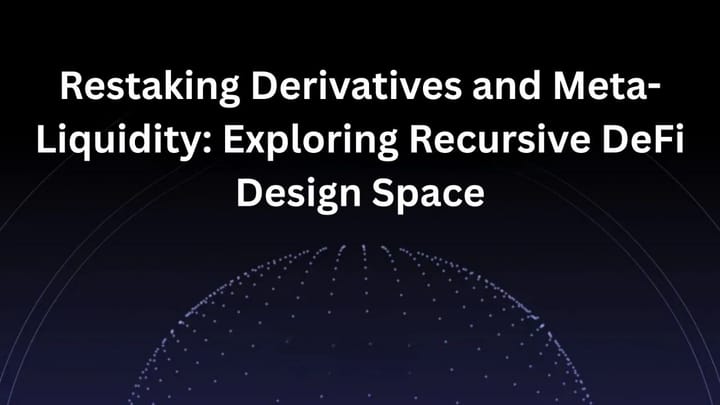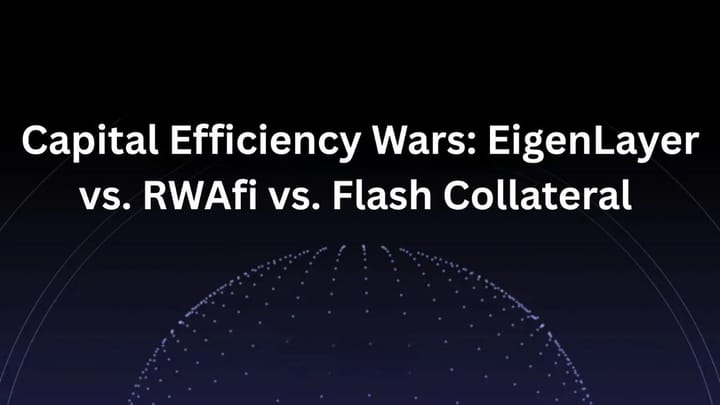Beyond DeFi: How Mitosis Powers Cross-Chain Gaming, RWAs, and More

Introduction: Liquidity Is Bigger Than DeFi
Decentralized finance (DeFi) introduced unparalleled financial accessibility, but liquidity remains siloed within individual blockchains. This fragmentation has ripple effects across multiple Web3 sectors, especially in gaming, real-world assets (RWAs), and NFTs.
Each of these industries is dependent on liquidity, yet today, moving value across chains is inefficient, costly, and often insecure. Whether it’s gamers trading assets, investors managing tokenized RWAs, or NFT traders seeking better markets, the ability to move liquidity freely is critical.
Mitosis is stepping in to solve this?
By providing a modular liquidity framework, Mitosis removes the need for:
- Bridges that expose users to risks
- Wrapped assets that create inefficiencies
- Manual liquidity transfers that slow down ecosystems
The result? Seamless, trust-minimized liquidity movement across all Web3 applications.
Let’s explore how Mitosis is unlocking a new era of cross-chain composability beyond DeFi.
1. Cross-Chain Gaming: The Key to an Open Metaverse
Gaming economies have long relied on in-game currencies, digital assets, and marketplaces to drive engagement and player retention. But with Web3 gaming, an even bigger challenge emerges—interoperability across blockchains.
The Problem: Why Gaming Liquidity is Broken
Web3 gaming projects often operate on isolated chains, creating liquidity barriers between different ecosystems. Players face several issues:
- Siloed Assets: Tokens and NFTs are often locked to a single chain, restricting cross-game utility.
- Expensive & Risky Bridges: Players must bridge tokens to move assets between gaming ecosystems, exposing themselves to smart contract risks and high gas fees.
- Fragmented Gaming Markets: Game developers struggle to attract liquidity, as players must convert assets manually to participate in different game economies.
How Mitosis Fixes This?
Mitosis removes the liquidity bottleneck by allowing game assets and currencies to move natively across chains without bridging.
- Modular Liquidity: Enables gaming tokens to be used across multiple chains in real time.
- Seamless Interoperability: Gamers can spend, trade, and use assets across multiple games without extra steps.
- Trust-Minimized Execution: No need to rely on centralized relayers or wrapped assets.
💡 Use Case Example: A Truly Cross-Chain Gaming Experience
Imagine a player earns gold tokens in an Ethereum-based RPG but wants to spend them in a Solana-based shooter. Instead of using bridges or swapping manually, Mitosis ensures:
- Instant Liquidity Transfer → Gold tokens move seamlessly to Solana.
- Gas-Efficient Swaps → No need for expensive bridge fees.
- Multi-Game Utility → Players can participate in different game economies without friction.
Outcome: Web3 gaming finally becomes a true multi-chain experience, making the open metaverse a reality.
2. RWAs: Unlocking Institutional-Grade Liquidity
Real-world assets (RWAs) are one of the fastest-growing sectors in blockchain, with billions of dollars in tokenized assets including real estate, stocks, bonds, and commodities. However, liquidity fragmentation prevents them from reaching their full potential.
The Problem: Why RWAs Struggle with Liquidity
For RWAs to work, they must be easily accessible and liquid across multiple blockchains. However, today’s reality is:
- Siloed RWA Markets → Investors must manually move liquidity between chains to participate.
- Capital Inefficiency → Traditional institutions find it difficult to use tokenized assets across DeFi protocols.
- Limited Cross-Chain Utility → Tokenized assets are often stuck in one ecosystem, restricting composability.
How Mitosis Bridges the Gap?
Mitosis provides a modular liquidity network that ensures RWAs can move seamlessly across multiple chains without wrapping.
- Cross-Chain Asset Portability: Tokenized RWAs can be transferred and utilized on any blockchain.
- Efficient Collateralization: Investors can use RWAs as collateral across different lending protocols.
- Institutional-Ready Infrastructure: Capital flows smoothly between traditional finance (TradFi) and DeFi.
💡 Use Case Example: RWA Tokenization at Scale
An institutional investor holds a tokenized real estate asset on Polygon but wants to use it as collateral for a loan on BNB Chain.
With Mitosis:
i. No bridging required → The asset’s liquidity moves seamlessly.
ii. Trust-minimized execution → Institutions avoid security risks of bridges.
iii. Higher capital efficiency → RWAs become more usable in DeFi.
Outcome: RWA adoption accelerates, bringing institutional capital into Web3.
3. NFTs, DAOs & The Future of Modular Liquidity
NFT marketplaces, DAOs, and emerging Web3 sectors all require fluid liquidity to operate at scale. However, today’s fragmented infrastructure limits their growth.
The Problem: Web3's Liquidity Divide
- NFTs: Most marketplaces are isolated to single chains, reducing buyer liquidity.
- DAOs: Multi-chain treasuries are difficult to manage, leading to inefficient capital allocation.
- Decentralized Identity & AI: These sectors require interoperable liquidity models to scale.
How Mitosis Solves This?
Mitosis ensures NFTs, DAOs, and new Web3 applications can access borderless liquidity in a decentralized way.
- NFT Marketplaces → Buyers and sellers can transact across multiple chains, improving liquidity.
- DAO Treasuries → Funds can be efficiently allocated across ecosystems without manual transfers.
- Web3 Innovation → Decentralized identity, AI, and new sectors gain instant access to capital.
Outcome: A more efficient, composable, and scalable Web3 ecosystem.
4. Why Mitosis Is the Infrastructure Layer for a Multi-Chain Future
Traditional cross-chain solutions (bridges, wrapped assets, and centralized relayers) aren’t built to scale beyond DeFi. As blockchain adoption grows, liquidity must flow seamlessly across all applications.
- No more fragmented liquidity pools.
- No more complex bridging processes.
- No more inefficient capital allocation.
Mitosis is building the liquidity backbone for all on-chain applications—DeFi and beyond.
Conclusion: Mitosis is the Future of Web3 Liquidity
The Web3 landscape is expanding rapidly, with gaming, RWAs, NFTs, and DAOs all demanding better liquidity solutions. Yet, the reality is that liquidity remains fragmented, inefficient, and trapped within isolated ecosystems.
Traditional cross-chain methods—bridges, wrapped assets, and centralized relayers—are not sustainable. They introduce security risks, inefficiencies, and friction that hinder the very innovation blockchain aims to unlock.
The Old Way vs. The Mitosis Way
❌ The Old Way:
- Relying on bridges that are vulnerable to exploits
- Using wrapped assets that reduce efficiency
- Manually moving liquidity across chains, wasting time and resources
✅ The Mitosis Way:
- Trust-minimized liquidity movement across chains
- Native cross-chain interoperability for gaming, RWAs, and NFTs
- Frictionless transactions without reliance on outdated infrastructure
Mitosis is not just another cross-chain protocol—it is the liquidity backbone of Web3, ensuring assets can flow freely between any blockchain without compromising on security or efficiency.
Why This Matters Now More Than Ever?
As Web3 adoption grows, the demand for seamless liquidity movement will only increase. Without scalable liquidity solutions, innovation will continue to be bottlenecked by outdated infrastructure.
Mitosis is changing that. By providing a modular liquidity network, it enables:
i. Cross-chain gaming economies where assets can move instantly
ii. RWA markets that are actually liquid and composable
iii. NFT marketplaces that aren’t restricted to a single chain
iv. DAOs with seamless treasury management across ecosystems
This is not just about making transactions easier—it’s about unlocking the true potential of Web3.
The Road Ahead
The shift towards a fully interoperable blockchain future is happening now. Projects that embrace Mitosis’ modular liquidity will be at the forefront of this evolution, while those stuck in outdated liquidity models will be left behind.
Mitosis isn’t just an upgrade—it’s a necessity for the next phase of Web3.
Are you ready to be part of the liquidity revolution?


Comments ()